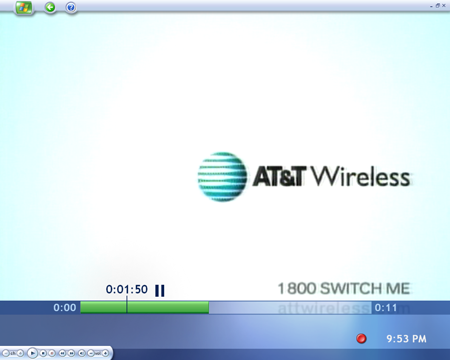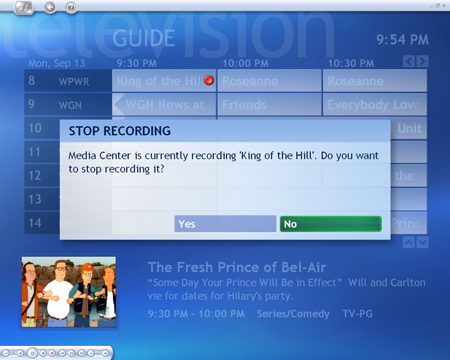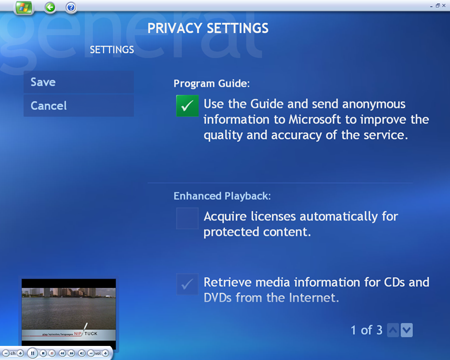
Original Link: https://www.anandtech.com/show/1476
Building a Linux PVR, Part 2: Microsoft's MCE 2004
by Purav Sanghani on September 16, 2004 12:05 AM EST- Posted in
- Linux
Introduction
A few weeks ago, we introduced the first of a series of articles on building a home made PVR, "Building a Linux PVR Part I - MythTV Setup and Install". Today, we bring you the second part of the series, which focuses on Microsoft's Windows XP Media Center Edition 2004 and how it compares to the Linux-based MythTV.When Microsoft first introduced their Media Center Edition of Windows, many saw this as a great opportunity to acquire a cheap PVR, since it was combined with a PC that could be used for the usual day-to-day tasks, such as word processing or browsing the Internet. But with that, Microsoft decided to bundle MCE with custom PCs that are built using the short list of supported hardware by big names in the industry, such as Hewlett-Packard and Gateway Computers. It could not be bought off store shelves by PC enthusiasts who already had hardware capable of PVR operations, nor did Microsoft plan on supporting hardware besides those from the few names it worked with.
Fast forward to today where Microsoft has begun selling OEM versions of their Media Center Edition to "Mom and Pop" shops to be installed on only Media Center Edition certified machines. This is a step forward, since it gives more power to those smaller shops. Media Center Edition still does not have support for the long list of hardware that MythTV does, but Microsoft has expanded their driver list quite a bit from their first release.
Although we installed MythTV from scratch in the previous review, we will use KnoppMyth in this half of the analysis. KnoppMyth installs cleanly and easily, but does not offer as much support as getting your hands dirty with a "from scratch" install.
Media Center Edition 2004 vs MythTV
A quick recap on what we found when building our MythTV box a few weeks ago:- MythTV is a third party application that runs on various Linux distros, including SuSE Linux 9.1, on which we based our PVR. A few others are Mandrake, Red Hat, and Debian. It can also install from a CD in about 20 minutes, with minimal configuration, using KnoppMyth. That's what we are using for this portion of the analysis.
- MythTV is compatible with various TV capture cards, including software and hardware based encoders/decoders (WinTV GO, WinTV PVR-250/350, AverTV Desktop PVR, etc). Generally, if hardware is supported in Linux, it can be at least forced to run on MythTV.
- MythTV does not have high hardware requirements. It will operate on a slower Pentium II machine with some quality loss, of course, but will compensate for weaker CPU configurations if a hardware-based capture card is used.
- MythTV supports plug-ins, which makes it a piece of software that can be expanded upon and, being open source, can be tailored to anyone's personal needs. Encoding capabilities, most importantly, can be expanded to allow use of various codecs and compression techniques.
- Windows Media Center Edition 2004 is, of course, proprietary software, which means that it cannot be altered or tailored to different needs. Since it is proprietary, though, it is fully supported by Microsoft when installed on certified hardware by certified vendors.
- Media Center Edition 2004 does not support software-based encoding, which means that a hardware-based capture card, such as the PVR-250/350 from Hauppauge, is required.
- Video encoding is based on Microsoft's own codec and cannot be changed to allow use of various other codec's such as DivX or MPEG2 codecs for DVD output.
- Configuration is just as simple as Microsoft's other products, like the original flavors of Windows. Some may disagree, but compared to Linux, Microsoft packages are a snap to install and configure.
The Test
From here on out, we will do some exhaustive analysis on various components of the two setups. These include hardware, interface, codecs, video capture quality and other features.We will be comparing hardware in both of our test machines to see which gives more bang for the buck and which is just more wallet-friendly. Since Part I, we have tried to strip down our MythTV system to bring the total cost as low as possible while maintaining a functional system.
With different software packages comes a variance of front ends. We will be comparing/contrasting these differences between MCE and MythTV to see which has the best interface in this Part II.
As far as the main function goes for a PC-based PVR, the most important benchmark that we would need to test is how well the core codec deals with encoding and decoding content. We will be comparing screenshots and audio/video captures from MCE and MythTV to see which package performs the best with its given hardware.
Besides the main functionality of these packages, we look to see what other features each package has implemented to pull it to the top of the list. Some of these features may be rudimentary such as weather feeds from certain websites or on-demand content systems.
We predict this comparison to be a close one, since both packages have much to offer. So, let's not waste any time...
Hardware
We made a few changes to our Linux MythTV system since Part I:| AnandTech Linux Device | Price | |
| CPU | Sempron 3100+ | $125 |
| MOBO | DFI K8M800-MLVF | $81 |
| Audio | Integrated (VIA) | - |
| Ethernet | Integrated (Realtek 10/100) | - |
| VGA | Integrated | - |
| Tuner | 2 Hauppauge WinTV GO | $100 |
| HDD | Western Digital 80GB WD800JB | $60 |
| RAM | 512MB Corsair DDR400 | $75 |
| Optical | BenQ 16X OPAL-OC1 | $24 |
| Remote | Included with WinTV GO | - |
| Case | SuperFlower SF-101BK | $38 |
| OS | SuSE Linux 9.1 | - |
| Total | $503 | |
We figured that we could chop the total price down by at least $100 using a WinTV GO card at $50 instead of the PVR-250 and also getting a hold of a much cheaper case from SuperFlower, the SF-101BK at $38. We used the same DFI board as in our original configuration from Part I. We went with the DFI K8M800-MLVF as an excellent low-cost solution for our MythTV platform; we get integrated graphics and sound, but we can still utilize the power of an onboard memory controller with socket 754. Since our MythTV setup is not 64-bit, going with a Sempron 3100+ over an Athlon 64 2800+ saves us a few bucks. With the money saved on this revision of the MythTV machine, we are actually able to use two WinTV GO cards - two tuners - allowing us to watch and record different signals at once. Both of these are software recording cards, but with the power of our Sempron 3100+, Myth is able to play video from one card, capture from the other, and transcode in the background without hiccupping! That's getting a bang for your buck.
Note: All of our benchmarks and comparisons performed on the MythTV system have been done with our original hardware setup, which includes the PVR-250, to balance the playing field.
Since MCE does not have the best compatibility when it comes to hardware, we had to accept some minor changes to hardware making it slightly difficult to cut down the price.
| Whitebox Windows MCE Device Price | Price | |
| CPU | Sempron 3100+ | - |
| MOBO | Undisclosed | - |
| Audio | Integrated (VIA) | - |
| Ethernet | Integrated (Realtek 10/100) | - |
| VGA | GeForce 4 MX440 128MB | - |
| Tuner | Hauppauge WinTV PVR-250MCE | - |
| HDD | Western Digital 80GB WD800JB | - |
| RAM | 512MB Micron DDR400 | - |
| Optical | Sony DDU-1613 | - |
| Remote | Undisclosed | - |
| Case | Undisclosed | - |
| OS | Windows XP Media Center Edition 2004 | - |
| Total | $699 | |
Our Media Center Edition PC came equipped with the same GeForce4 MX440, but with 64MB more RAM. MCE also has better support for the MCE version of Hauppauge's PVR-250, appropriately named PVR-250MCE. Other variations in hardware were the 512MB Micron DDR400 (from our MythTV PVR's Corsair DR400) as well as the Sony DDU-1613 CD/DVD combo reader (from the BenQ OPAL-OC1).
From the price, it is clear that our stripped down MythTV box comes up as the winner here, but it does at the cost of performance. Since we used the software-based WinTV GO card, MythTV relied heavily on the Sempron 3100+ for encoding/decoding functions. The Sempron was still powerful enough to handle simple recording and playback of audio/video content.
Interface
As our screenshots showed in Part I, MythTV had a clean and extremely attractive look to it, which of course could be skinned to make it more customizable for the user. MCE has an equally attractive interface with clean lines, vibrant colors, and large text that will display perfectly on even the lowest end displays.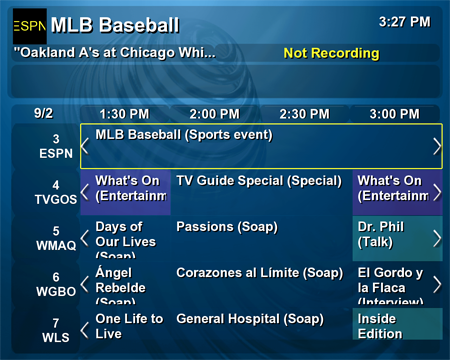
The MythTV programming guide.
Click to enlarge.
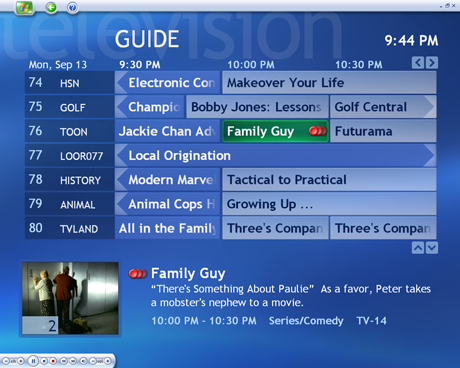
The MCE 2004 programming guide.
Click to enlarge.
As you can see, the basic idea of a programming guide is implemented similarly in both instances. MCE's layout does look a bit cleaner with refined lines, and also, the feature that puts MCE on top in this screen is the live display on the bottom left.
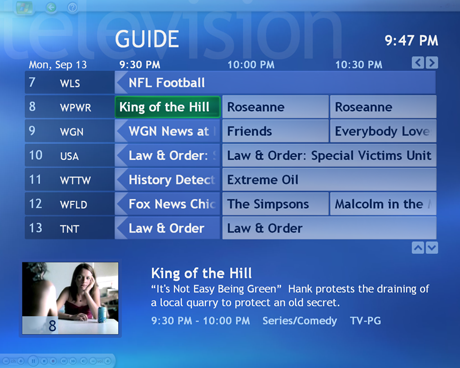
Another MCE programming guide screen.
Click to enlarge.
This next screenshot displays settings for the location in which recorded programs are to be stored. The total allocation as well as quality of recording can be adjusted. The total and unused recording time will be calculated automatically upon the change of settings.
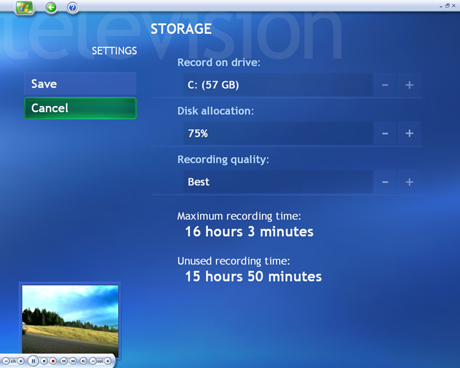
Report of disk space usage in MCE 2004.
Click to enlarge.
Myth has several other advantages here too. Using KnoppMyth, we are actually capable of remote scheduling - i.e. we can set up a scheduling queue from the internet for our machine via a web interface. Myth also allows us to use multiple front ends for the same video source. This is something that we will talk about later, but becomes a very important feature when we start adding multiple tuners later in the analysis.
Codecs
Unlike MythTV's virtually endless possibilities for using different codecs to transcode audio/video, MCE is designed only record with an MPEG2-based codec with the extension ".dvr-ms". These MPEG2 streams are created specifically with MCE features in mind, such as time shifting, live pause and simultaneously recording, and playing back audio and video. DVR-MS is really nothing more than MPEG2 wrapped in an encrypted ASF wrapper. DVR-MS has 3 quality settings that we mentioned on the previous page.These .dvr-ms files can be played back on regular Windows XP machines unless they are copy-protected by the broadcaster, in which case they will only be able to play on the original Media Center PC where it was recorded, and only in Windows Media Player, we might add. There are some utilities that will covert dvr-ms files to MPEG2 DVD compliant files, but that is beyond the scope of our topic and is not supported by Microsoft.
Unfortunately, we have a large issue with the amount of disk space that the MPEG2 codec consumes. A 15-minute clip of video can take as much as 400MB. MythTV does not perform much better when video is downloaded at high quality, but we have the option to transcode, or re-render the MPEG stream into something a little more versatile. For example, we can compress our cartoon captures down to a lower quality MPEG1 codec without sacrificing much quality; or with a XviD plugin, we can transcode our entire library into MPEG4 in the background. Note that we are using the same Sempron 3100+ processor in both machines!
In this analysis, we are taking video capture from analog cable. We are able to capture digital cable from a digital cable feed as well, but it requires the MCE machine to use a special IR module that actually controls the digital cable box. This can be done with MythTV under LIRC as well.

A sample clip from MCE 2004.
Click to enlarge.

A close-up from MCE 2004.
Taking a small 200px square sample from the analog cable feed above, we see a bit of interference. This is more of a problem with our cable feed than MCE or MythTV, but on MythTV, we are able to use a lower quality codec to capture or transcode the signal. Using an MPEG2 stream to capture a low quality signal at 1.2GB per hour seems like a ridiculous waste of space. With MythTV, we are given the option to keep this kind of signal as a 480i MPEG1 stream instead.
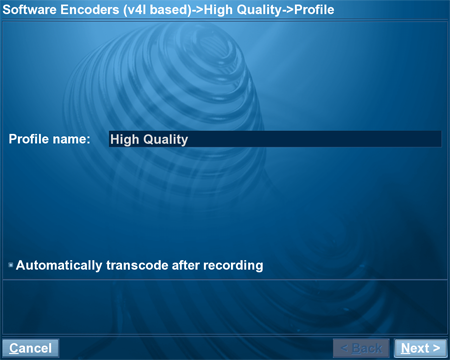
MythTV's transcoding option.
Click to enlarge.
Playing Video
Unfortunately, MythTV took its first real stumble at DVD playback. Using the machine that we installed from scratch in Part I of the analysis, we had zero issues playing DVDs. Under KnoppMyth, the DVD completely refused to play. We would hear the DVD start up, spin and then just hang. Part of this may have to do with copy-protection, part of it may have to do with poorly constructed code. In either case, we can't watch "Nip Tuck" on the KnoppMyth machine without some serious changes to the install. The ability to make changes to KnoppMyth after it has already been installed is one quality that it severely lacks.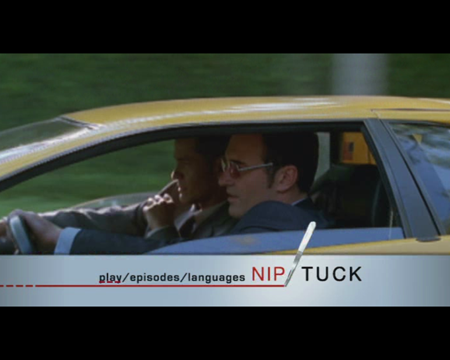
Sample DVD playback under MythTV from Scratch machine
Click to enlarge.
Both machines utilize all the features that you would expect from TiVo. We can pause, rewind and replay live TV. Below, you can see us pause during a commercial while the program continues to record.
Of course, on the MythTV machine, we are actually able to skip the commercials entirely. MythTV surpasses MCE completely in this respect. During our tests, 9 out of 10 commercial breaks were skipped flawlessly. ReplayTV's accuracy may be slightly higher than this, but for a free solution, Myth does an excellent job.
Polishing to Perfection
We had briefly mentioned earlier some of the loose ends. Even though Myth provides dozens of extra features over MCE, the fact remains that Myth does not have that clean-cut feel. The little features bundled with MCE give it the competitive edge. For example, MCE continues to record even if the program is not open - Media Center is integrated into the OS. If we attempt to power down, we are notified before doing so.Furthermore, if the cable goes out or an error occurs while recording in MythTV, we are given very little notification of a problem. MCE makes sure to let us know if something occurs incorrectly.
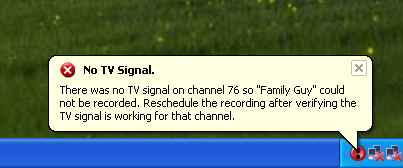
Windows MCE
Also, if we try to change a channel while recording, we are notified.
Of course, Myth does have some extra features that MCE cannot compete with as well. We do not necessarily worry about watching one program while recording on another in MythTV because we simply use two WinTV Go capture cards. If we attempt to record a third program, Myth pops up a warning.
Arguably, our favorite feature found on MCE and not on MythTV was the continuous thumbnail video feed. Those who use UltimateTV are fully aware of this feature, and don't even consider it a feature, but just a fact of life. No matter which particular menu in which we browse, we continuously play the DVD or TV in the lower left. MythTV falls very short in this aspect of playback quality, but it is something we are sure that they are working on. Below, you can see an example of what we mean (along with a very ominous Microsoft privacy setting).
Scaling the signal, while recording another and transcoding video files in the background, might be expecting too much from our MythTV hardware.
More Features
Upon loading MCE for the first time, we didn't expect to find any out-of-the-ordinary features bundled in the package. After a thorough inspection, we were surprised to find what was implemented in MCE 2004.For starters, MCE has full radio support with the WinTV PVR-250MCE card, something MythTV lacks. We may see a plug-in in the future for MythTV, but for now, its features are limited. MCE's radio capabilities include the basic functions found in typical home stereos.
A small feature that has been employed into both MythTV and MCE is a Caller ID feature, which let's a user see who is calling when the system is hooked up to a phone line. This feature comes built into MCE, but is designed as a plug-in for MythTV.
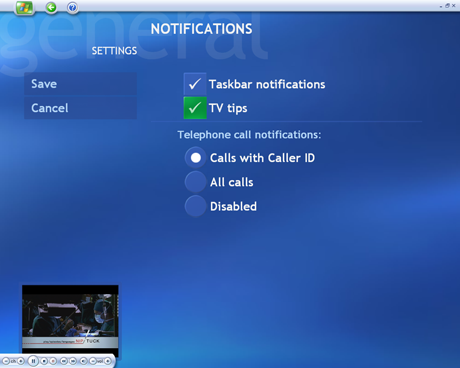
MCE's Caller ID ability.
Click to enlarge.
We were amazed to find an on-demand content system in MCE. The online content is hosted by MovieLink for $4.95 or less per title. Once purchased, movies can either be stored for a period of time, 30 days for our "Cold Mountain" purchase, or played as many times as possible within a 24-hr period. Since the video began playing while it was downloading, it was a bit choppy, even over a 6Mbit connection. The quality of movies is excellent, though, comparable to 480p quality. Also keep in mind that all of the On-Demand programming is copy-protected, meaning that it can only be played back on the MCE system with which it was purchased.
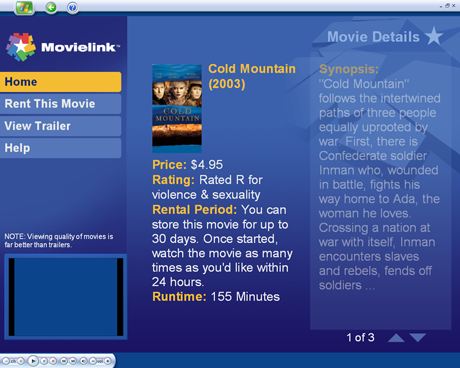
On-Demand feature of MCE 2004.
Click to enlarge.
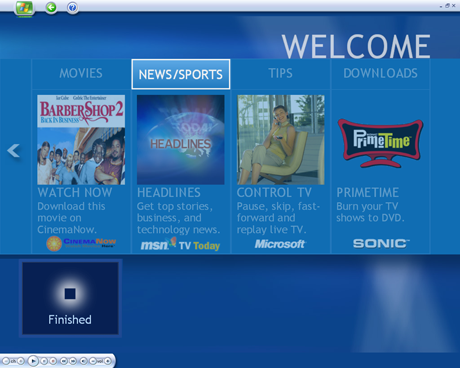
Another screen showing off On-Demand features.
Click to enlarge.
At the Intel Developer Forum in San Francisco last week, Intel proudly announced that the next version of Microsoft Windows Media Center Edition will indeed implement the Starz! streaming media service, which will undoubtedly improve the on-demand feature already used in MCE 2004.
Final Thoughts
There you have it, folks! Our comparison showed in detail what each alternative to set top box PVR's was capable of and we were excited by our results. Each package had the basic TV tuner, video capture/playback, and guide functionality, but each differed in its own way.Although the DVR-MS codec is certainly capable, it consumes far too much space. Transcoding is clearly something that MCE lacks in comparison to MythTV; fundamentally, MythTV has a more user-friendly model. Issues with legality may crop up in the future for KnoppMyth (due to its DVD Rip plugin), but as of right now, we can declare Myth the friendlier, more powerful recorder. Additional features like commercial skip, background transcoding and multiple tuner input for multiple channel recording only sweeten the deal.
As far as setup and configuration goes, MCE 2004 won this round. To be able to work with anything on Linux, especially a package like MythTV, one needs to know the ins and outs of the OS, which could become a hassle if you have incompatible hardware or buggy software/drivers. Since MCE 2004 is proprietary, there are only so many hardware configurations to deal with and all are supported if they are certified to run on the OS. If or when MCE becomes a retail operating system addition for Joe Consumer, similar install issues that plague Myth may crop up.
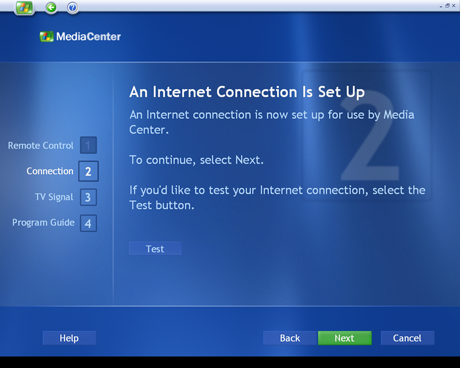
Click to enlarge.
Hold your mouse over to view the MCE 2004 setup screens.
With that, there is the hardware compatibility issue. MCE 2004 requires hardware certified by Microsoft to run successfully. This means that there is a very short, yet slowly growing, list of hardware which the package supports. One piece of hardware is the TV tuner card; MCE requires a hardware-based capture card, like the PVR-250MCE; otherwise, TV functionality will be disabled. MythTV, on the other hand, will accept various hardware as well as software-based TV tuner/capture cards if drivers are provided or even written by the user, hence the open-source status. Hopefully, when MCE2005 debuts next month, we will see even more increasing features and hardware support.
| Media Center Edition 2004 | MythTV | |
| Hardware | Limited compatibility of hardware. All hardware must be certified by Microsoft to be used in MCE, which means it is guaranteed to work. | Long list of compatible hardware. Hardware and software-based capture cards can be used. Also supports multiple tuners for simultaneous recording of two programs. Sempron 3100+ can handle multiple streams at once (recording, playing, transcoding). |
| Interface | Clean look with refined style. Full featured program guide that shows feed of current video source. Cannot be skinned. | Fully skinnable. Programming guide lacks live display of current channel/video source. |
| Codecs | Supports only MPEG2 streams with a proprietary DVR-MS wrapper. | Supports various codecs, namely MPEG4 background transcoding on previously recorded programs. |
| Recording Quality | High to low quality recordings with single MPEG2 codec. | High to low quality recordings through various codecs. |
| Playback | Can be played back on software supporting .dvr-ms file extension. Copy-protected media can be played back only on originating MCE PC. | Depending on which codecs are used, programs can be played back on any machine with the right codecs. Multiple tuner support means multiple programs viewable at once. |
| Other Features | On-Demand programming feature. Fully implemented Caller ID feature. Integrated radio support. |
Support for extra features can be readily implemented using plug-ins (weather, DVD playback/transcoding, RSS news feeds) |
| Installation and Settings | Out-of-the-box package. Easy to install and configure. Requires minimal setup. | Open source package. Requires knowledge of Linux and may require additional modification/configuration of drivers and other source code. |
We were extremely impressed by how much we could do with such relatively weak hardware on the MythTV machine. We were able to capture multiple software encodes via the WinTV GO cards and transcode our high quality rips down to MPEG1 in the background on very modest hardware.
Our analysis has proved that though Media Center Edition 2004 is a boxed package that is easy to set up and configure, it looks amazingly beautiful, has great features such as On-Demand content, and is fully supported by Microsoft. However, for the enthusiast, MythTV takes the gold for its greater support for a variety of hardware and software codecs.
We all know an open source package is not fully supported by a single company that will guarantee compatibility with certified hardware, but Linux enthusiasts are promised a product with no limits regarding features and customization. The sky is the limit for MythTV's use of plug-ins and codecs, and even though it is already an amazing piece of software, we have yet to see its extreme possibilities and ultimate potential.

